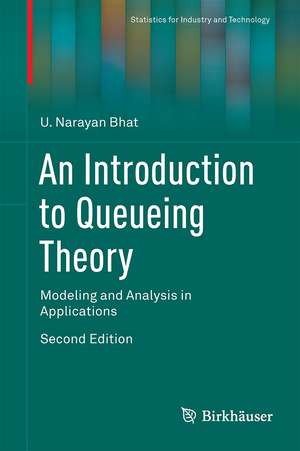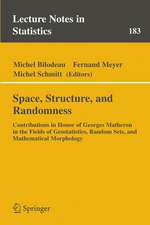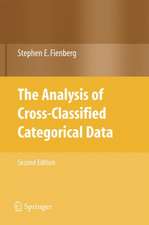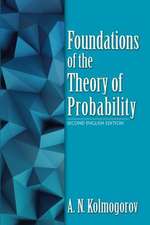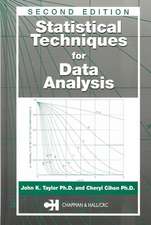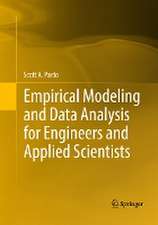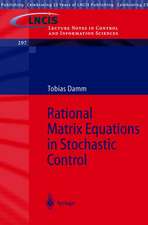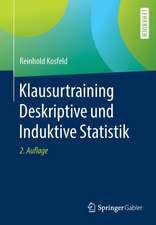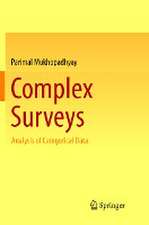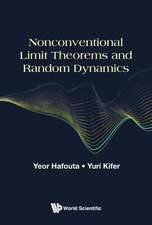An Introduction to Queueing Theory: Modeling and Analysis in Applications: Statistics for Industry and Technology
Autor U. Narayan Bhaten Limba Engleză Hardback – 9 iul 2015
Key features:
• An introductory chapter including a historical account of the growth of queueing theory in more than 100 years.
• A modeling-based approach with emphasis on identification of models
• Rigorous treatment of the foundations of basic models commonly used in applications with appropriate references for advanced topics.
• A chapter on matrix-analytic method asan alternative to the traditional methods of analysis of queueing systems.
• A comprehensive treatment of statistical inference for queueing systems.
• Modeling exercises and review exercises when appropriate.
The second edition of An Introduction of Queueing Theory may be used as a textbook by first-year graduate students in fields such as computer science, operations research, industrial and systems engineering, as well as related fields such as manufacturing and communications engineering. Upper-level undergraduate students in mathematics, statistics, and engineering may also use the book in an introductory course on queueing theory. With its rigorous coverage of basic material and extensive bibliography of the queueing literature, the work may also be useful to applied scientists and practitioners as a self-study reference for applications and further research.
"...This book has brought a freshness and novelty as it deals mainly with modeling and analysis in applications as well as with statistical inference for queueing problems. With his 40 years of valuable experience in teaching and high level research in this subject area, Professor Bhat has been able to achieve what he aimed: to make [the work] somewhat different in content and approach from other books." - Assam Statistical Review of the first edition
Din seria Statistics for Industry and Technology
- 18%
 Preț: 965.02 lei
Preț: 965.02 lei -
 Preț: 407.01 lei
Preț: 407.01 lei - 18%
 Preț: 958.38 lei
Preț: 958.38 lei -
 Preț: 404.89 lei
Preț: 404.89 lei - 18%
 Preț: 1240.30 lei
Preț: 1240.30 lei - 18%
 Preț: 1234.00 lei
Preț: 1234.00 lei - 15%
 Preț: 651.34 lei
Preț: 651.34 lei - 5%
 Preț: 1124.07 lei
Preț: 1124.07 lei - 18%
 Preț: 973.38 lei
Preț: 973.38 lei - 18%
 Preț: 1017.11 lei
Preț: 1017.11 lei - 18%
 Preț: 965.20 lei
Preț: 965.20 lei - 15%
 Preț: 651.19 lei
Preț: 651.19 lei - 15%
 Preț: 655.60 lei
Preț: 655.60 lei -
 Preț: 421.43 lei
Preț: 421.43 lei - 18%
 Preț: 1244.89 lei
Preț: 1244.89 lei -
 Preț: 407.19 lei
Preț: 407.19 lei -
 Preț: 400.65 lei
Preț: 400.65 lei -
 Preț: 397.38 lei
Preț: 397.38 lei - 18%
 Preț: 1109.44 lei
Preț: 1109.44 lei -
 Preț: 409.89 lei
Preț: 409.89 lei - 15%
 Preț: 640.55 lei
Preț: 640.55 lei -
 Preț: 400.26 lei
Preț: 400.26 lei - 15%
 Preț: 665.08 lei
Preț: 665.08 lei - 15%
 Preț: 661.48 lei
Preț: 661.48 lei - 18%
 Preț: 962.98 lei
Preț: 962.98 lei - 18%
 Preț: 1132.33 lei
Preț: 1132.33 lei - 18%
 Preț: 1124.30 lei
Preț: 1124.30 lei - 18%
 Preț: 966.59 lei
Preț: 966.59 lei
Preț: 784.59 lei
Preț vechi: 956.81 lei
-18% Nou
Puncte Express: 1177
Preț estimativ în valută:
150.15€ • 163.04$ • 126.13£
150.15€ • 163.04$ • 126.13£
Carte tipărită la comandă
Livrare economică 22 aprilie-06 mai
Preluare comenzi: 021 569.72.76
Specificații
ISBN-13: 9780817684204
ISBN-10: 0817684204
Pagini: 339
Ilustrații: XIV, 339 p. 18 illus., 6 illus. in color.
Dimensiuni: 155 x 235 x 24 mm
Greutate: 0.67 kg
Ediția:2nd ed. 2015
Editura: Birkhäuser Boston
Colecția Birkhäuser
Seria Statistics for Industry and Technology
Locul publicării:Boston, MA, United States
ISBN-10: 0817684204
Pagini: 339
Ilustrații: XIV, 339 p. 18 illus., 6 illus. in color.
Dimensiuni: 155 x 235 x 24 mm
Greutate: 0.67 kg
Ediția:2nd ed. 2015
Editura: Birkhäuser Boston
Colecția Birkhäuser
Seria Statistics for Industry and Technology
Locul publicării:Boston, MA, United States
Public țintă
GraduateCuprins
Introduction.- System Element Models.- Basic Concepts in Stochastic Processes.- Simple Markovian Queueing Systems.- Imbedded Markov Chain Models for M/G/1 and G/M/1 Queues.- Extended Markov and Renewal Models.- Queueing Networks.- Matrix-Analytic Queueing Models.- The General Queue G/G/1 and Approximations.- Statistical Inference for Queueing Models.- Decision Problems in Queueing Theory.- Queueing Theory Applications in the Analysis of Manufacturing Systems.- Queueing Theory Applications in the Analysis of Computer and Communication Systems.- Simulating Queueing Systems.
Recenzii
“This is a well-written textbook for upper-level undergraduate or graduate students in computer science or engineering who study network performance, design or other technological disciplines that include queueing theory. … All necessary concepts on the theory of Markov processes as well as techniques for modeling and analysis of queueing systems are given in examples.” (Vyacheslav Abramov, zbMATH 1333.60001, 2016)
Notă biografică
U. Narayan Bhat is a Professor Emeritus in the Statistical Science Department at Southern Methodist University, Texas, USA. His research interests include: queueing theory, probability models for computer and communication systems, reliability and statistics and applied probability and statistics.
Textul de pe ultima copertă
This introductory textbook is designed for a one-semester course on queueing theory that does not require a course on stochastic processes as a prerequisite. By integrating the necessary background on stochastic processes with the analysis of models, the work provides a sound foundational introduction to the modeling and analysis of queueing systems for a wide interdisciplinary audience of students in mathematics, statistics, and applied disciplines such as computer science, operations research, and engineering. This edition includes additional topics in methodology and applications.
Key features:
• An introductory chapter including a historical account of the growth of queueing theory in more than 100 years.
• A modeling-based approach with emphasis on identification of models.
• Rigorous treatment of the foundations of basic models commonly used in applications with appropriate references for advanced topics.
• Applications in manufacturing and,computer and communication systems.
• A chapter on matrix-analytic method as an alternative to the traditional methods of analysis of queueing systems.
• A comprehensive treatment of statistical inference for queueing systems.
• A chapter on the simulation of queueing systems.
The second edition of An Introduction of Queueing Theory may be used as a textbook by first-year graduate students in fields such as computer science, operations research, industrial and systems engineering, as well as related fields such as manufacturing and communications engineering. Upper-level undergraduate students in mathematics, statistics, and engineering may also use the book in an introductory course on queueing theory. With its rigorous coverage of basic material and extensive bibliography of the queueing literature, the work may also be useful to applied scientists and practitioners as a self-study reference for applications and further research.
Review of the first edition:
"This book is precisely what the title says it is. It is aimed at beginning graduate students and advanced undergraduate students in industrial engineering, electrical engineering, computer science, operations research, management science, mathematics and statistics...it covers a surprisingly large number of topics, including some that do not get much attention in other, much larger books...At the end of many chapters is a welcome Remarks section...(that) provide further references...Is there a need for another book on queueing theory? For this book - yes, there is."-American Statistical Association and the American Society for Quality. Review appeared in TECHNOMETRICS, Feb. 2010. VOL. 52.
Key features:
• An introductory chapter including a historical account of the growth of queueing theory in more than 100 years.
• A modeling-based approach with emphasis on identification of models.
• Rigorous treatment of the foundations of basic models commonly used in applications with appropriate references for advanced topics.
• Applications in manufacturing and,computer and communication systems.
• A chapter on matrix-analytic method as an alternative to the traditional methods of analysis of queueing systems.
• A comprehensive treatment of statistical inference for queueing systems.
• A chapter on the simulation of queueing systems.
The second edition of An Introduction of Queueing Theory may be used as a textbook by first-year graduate students in fields such as computer science, operations research, industrial and systems engineering, as well as related fields such as manufacturing and communications engineering. Upper-level undergraduate students in mathematics, statistics, and engineering may also use the book in an introductory course on queueing theory. With its rigorous coverage of basic material and extensive bibliography of the queueing literature, the work may also be useful to applied scientists and practitioners as a self-study reference for applications and further research.
Review of the first edition:
"This book is precisely what the title says it is. It is aimed at beginning graduate students and advanced undergraduate students in industrial engineering, electrical engineering, computer science, operations research, management science, mathematics and statistics...it covers a surprisingly large number of topics, including some that do not get much attention in other, much larger books...At the end of many chapters is a welcome Remarks section...(that) provide further references...Is there a need for another book on queueing theory? For this book - yes, there is."-American Statistical Association and the American Society for Quality. Review appeared in TECHNOMETRICS, Feb. 2010. VOL. 52.
Caracteristici
The first textbook on queueing theory that does not require a course in stochastic processes as a prerequisite Suitable for applied science students not needing a specialized course in queueing theory Modeling exercises are included as a motivational tool; review exercises cover background material on statistical distributions Includes a chapter on modeling using computational tools Chapter 10 material on statistical methods does not appear in any other introductory or even more advanced textbooks on queueing theory Instructor's guide to solutions of exercises available upon request Includes supplementary material: sn.pub/extras Request lecturer material: sn.pub/lecturer-material
